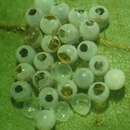en
names in breadcrumbs


Anastatus bifasciatus is a species of parasitoid wasp in the family Eupelmidae.[2] It is native to Europe, and has been harnessed for augmentative biological control against the brown marmorated stink bug, Halyomorpha halys.[3][2][4][5][6] The study by Haye et al., 2015 especially demonstrates its effectiveness against the European BMSB invasion.[3] It has also been considered as a biological control agent against spongy moth (Lymantria dispar) eggs in North America.[7]
A. bifasciatus is a widespread generalist egg parasitoid of various arthropods, especially lepidoptera and hemiptera.[2][4][5]
Females live for up to two months, while the males, which are smaller, only have adult lives of a few days.[5] Females feed on nectar and honeydew.[5][2]
Anastatus bifasciatus is a species of parasitoid wasp in the family Eupelmidae. It is native to Europe, and has been harnessed for augmentative biological control against the brown marmorated stink bug, Halyomorpha halys. The study by Haye et al., 2015 especially demonstrates its effectiveness against the European BMSB invasion. It has also been considered as a biological control agent against spongy moth (Lymantria dispar) eggs in North America.
A. bifasciatus is a widespread generalist egg parasitoid of various arthropods, especially lepidoptera and hemiptera.
Females live for up to two months, while the males, which are smaller, only have adult lives of a few days. Females feed on nectar and honeydew.